 The Nikon D300. Currently in waiting outside Chicago, USA. In my hands early May. For details, go in-depth reviews at dpreview.com or Ken Rockwell's site.
The Nikon D300. Currently in waiting outside Chicago, USA. In my hands early May. For details, go in-depth reviews at dpreview.com or Ken Rockwell's site.
blog
Banglamphu, April 22, 2008
 Temple doors, Wat Ratchabophit.
Temple doors, Wat Ratchabophit.

Live music on Thanon Khao San.
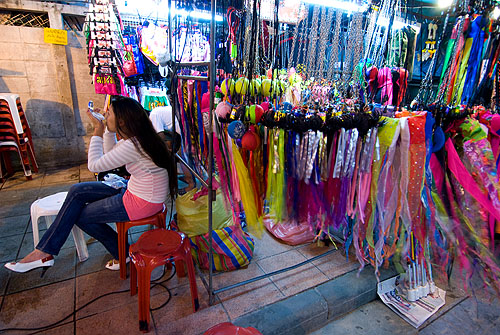
Making up on Thanon Khao San.

A vendor being chased away from Thanon Khao San.
Nay Lek (Uan)
 Arguably Bangkok's most popular hawker stall, Naay Uan's recipe for success must lie in its simplicity. His kuay jap, a basic but delicious soup of of pork offal, thick rice noodles and broth draws literally hundreds of hungry diners to Chinatown every night:
Arguably Bangkok's most popular hawker stall, Naay Uan's recipe for success must lie in its simplicity. His kuay jap, a basic but delicious soup of of pork offal, thick rice noodles and broth draws literally hundreds of hungry diners to Chinatown every night:

(For a larger version of this image go here.)
But that broth... Naay Uan's kuay jap broth is probably the most pepper-intense dish I've ever consumed. The guy must pour bags of ground white pepper into his broth, leaving the diner with a mildly burning, spicy sensation. For me this is the highlight, but I think most people come for the meat, which includes your choice of pork heart, stomach, tongue or crispy deep-fried pork.
Cnr Soi 11 & Th Yaowarat (Google Maps link) 02 224 3450 7pm-late
Dancefloor
 Bangkok, Thailand. ISO 2200.
Bangkok, Thailand. ISO 2200.
Lung Lek
 Have you ever rented a car and driven to another province for a bowl of noodles? That's exactly what me, Hock and Andy did this weekend. Andy is the owner of Pok Pok, a popular Thai restaurant in Portland, Oregon, and is on something of a noodle research expedition across Asia. I offered to contribute to this scholarship by taking him to Lung Lek, a noodle shop in Ayuthaya. Hock was kind enough to drive, his expensive mobile phone providing both navigational support and musical entertainment.
Have you ever rented a car and driven to another province for a bowl of noodles? That's exactly what me, Hock and Andy did this weekend. Andy is the owner of Pok Pok, a popular Thai restaurant in Portland, Oregon, and is on something of a noodle research expedition across Asia. I offered to contribute to this scholarship by taking him to Lung Lek, a noodle shop in Ayuthaya. Hock was kind enough to drive, his expensive mobile phone providing both navigational support and musical entertainment.
Lung Lek ('Uncle Lek') claims to have been making his unique 'boat-style' noodles (kuaytiaw ruea) for 30 years now. I reckon he's just about got it down. I really the beef version:

Unfortunately our first bowls were pretty mild, as seeing that we were not Thai, Lung Lek dumbed the flavours down, assuming we wouldn't be able to take the heat. Re-ordering brought us the bowl shown above. This type of noodle dish is called naam tok ('waterfall') and usually includes a swirl of fresh blood, but Lung Lek adds a tablespoon of the liquid used to marinade his beef. Like other boat noodles, his broth is laden with dried spices, and has a dark colour. Unlike others, Lung Lek's noodles aren't sweet, and his broth is much richer.
Lung Lek's nearly half-century investment has proven worthwhile, in my opinion. Now if he'd only put the ladle down for a day or two and consider improving the aesthetics of his restaurant (little more than rickety tables on a dirt floor under a ratty tarp). If he wishes to maintain some of the more rustic elements of the current restaurant he could could make the simple transition towards French Country, however I'd suggest something a bit more radical like the Queen Anne-inspired whimsy of Raul Villares Gayan's Nouveau series.
Lung Lek
Th Chee Kun (across from Wat Ratburana), Ayuthaya
9am-4pm
Tsukiji
 For a larger version of this image go here.
For a larger version of this image go here.
While on a recent visit to Tokyo, I spent four mornings exploring and taking photos of Tsukiji, the world famous seafood market. The highlight of the market for many is the famous tuna auction, which in the last decade has actually become a huge tourist destination. During each of my visits there were at least a hundred or more visitors, standing in the way, taking photos (often with flash, although very large signs asked that people not do this), and posing with the fish. Tiny forklifts are constantly buzzing by at breakneck speed, and the floor is very slippery--clearly not a place for tourists. Being Japanese, the bidders and auctioneers involved in the market were typically polite, but I could sense their frustration. In recent years this madness has reached tipping point, and there's word that since April this part of the market should now be closed to tourists.
As shown above and below, there are several expansive rooms lined with fresh and frozen tuna:

From about 5-6am the potential buyers carefully inspect the tuna, making notes:

looking closely:

and often tasting and smelling the tuna (spitting the meat out on the floor, to my surprise). When inspections are done, a bell rings and the auction takes place:

The highest bidders take their wares off to the interior of the market to be cut and prepared:

This was fascinating, but there's a lot more at Tsukiji than tuna. The entire market covers several cold and wet warehouses:

encompassing virtually every kind of seafood imaginable, from beautiful shrimp:

to crabs:

and fish:

Apparently the entire market is slated to move to another part of town in the next couple years, and will, I've heard, not be as open as the current one.
The entire photoset can be seen here.
Phuket Town
 It didn't take me long to discover that, unless you're a fan of mediocre Swedish food or bland Thai/Asian, you'll find little of interest to eat on the island of Phuket. The exception to this was Phuket Town, by far the most interesting and atmospheric place on the island, and virtually forgotten by the hordes of tourists who cling to the beaches. I was surprised to find that many of the traditional dishes you'll find there are nearly identical to those of Penang. This may not come as a big surprise to those familiar with history though, as there was apparently a great deal of trade between Phuket and the former Straits Settlements of Penang, Malacca and Singapore, and all of these areas were populated by similar Chinese ethnic groups.
It didn't take me long to discover that, unless you're a fan of mediocre Swedish food or bland Thai/Asian, you'll find little of interest to eat on the island of Phuket. The exception to this was Phuket Town, by far the most interesting and atmospheric place on the island, and virtually forgotten by the hordes of tourists who cling to the beaches. I was surprised to find that many of the traditional dishes you'll find there are nearly identical to those of Penang. This may not come as a big surprise to those familiar with history though, as there was apparently a great deal of trade between Phuket and the former Straits Settlements of Penang, Malacca and Singapore, and all of these areas were populated by similar Chinese ethnic groups.
And it is Chinese cuisine, often with a Southeast Asiann twist, that constitutes much of Phuket Town's traditional food. An example of this is mee hoon, a noodle dish known in Penang as bee hoon:

As well as lor bak:

Deep-fried porky savouries served with a dipping sauce almost identical to that which tops the Malaysian dish rojak. The bits at the top of the plate were nearly identical to hoy jor, and were really delicious.
There was pretty good dim sum:

And another interesting dish of Chinese origin, although I don't recall having seen it in Penang, is something called oh taao:

Somewhat similiar to hoy thawt or or suan, this dish combines chunks of taro, a batter, tiny oysters, egg, a deep red chili and a greenish garlic sauce, and my favourite part, crumbled bits of deep-fried pork rind!
There's a palpable Muslim influence in the city, and on several occasions I had some very tasty roti, both as a savoury breakfast (served with a small bowl of curry), or a sweet snack:

Just outside the city, Ko Sireh is also home to the island's biggest fishing port:

where every morning you can see heaps of interesting looking fish (and on one occasion, three very large sharks!) being unloaded. Not far from the fishing port I found a cool little cafe that served Thai-style coffee and lots of old-school sweets and snacks:

Despite how the look, many of them were just as savoury as they were sweet, and made a wonderful breakfast.
And lastly, if you're looking for something a bit more formal, you can't go wrong with Siam Indigo:

a restaurant housed in an beautiful 80 year old Sino-Portuguese building that does some excellent Thai, Thai-influenced and locally-influenced food.
The entire photoset can be seen here.
A different kind of curry
 I’m currently in Tokyo, so this is what my curries will be looking like for the next few days. I love this city and am here taking photos at Tsukiji, the world-famous seafood market, for a magazine article. Will post some pics from that, as well as some of the fun food I had in Phuket just before coming here, soon.
I’m currently in Tokyo, so this is what my curries will be looking like for the next few days. I love this city and am here taking photos at Tsukiji, the world-famous seafood market, for a magazine article. Will post some pics from that, as well as some of the fun food I had in Phuket just before coming here, soon.
In the meantime, do any of you who read this thing happen to live in Tokyo? I’ll be here until the 2nd and since the language barrier has largely limited me to eating things such as the above, I’d be more than willing to meet up for a real meal. My email can be found at my Bio/Contact page.
Tokyo, March 27 & 28, 2008
 At a smoking area, Shibuya, Tokyo, Japan.
At a smoking area, Shibuya, Tokyo, Japan.

Shinjuku, Tokyo, Japan.

Paper lanterns line a street in Shibuya, Tokyo, Japan.

Public awareness, Shinjuku, Tokyo, Japan.

Shinjuku reflected in a bus window, Tokyo, Japan.
The greatest
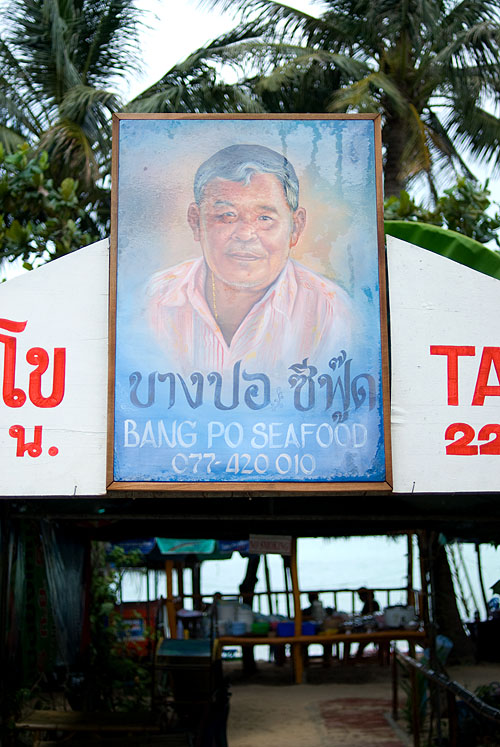 Throwing around superlatives can be a scary thing, but I think I'm justified in this case. I've been to many, many restaurants in Thailand, and have eaten some pretty amazing food, but Bangpo Seafood particularly stands out in my mind. I knew something was special about it after my first visit over a year ago, and wrote quite a few good things about it, but have always been keen to go back and see if the restaurant was really was as good as I thought.
Throwing around superlatives can be a scary thing, but I think I'm justified in this case. I've been to many, many restaurants in Thailand, and have eaten some pretty amazing food, but Bangpo Seafood particularly stands out in my mind. I knew something was special about it after my first visit over a year ago, and wrote quite a few good things about it, but have always been keen to go back and see if the restaurant was really was as good as I thought.
Well, after two recent visits, my initial impression was right, and I think Bangpo Seafood just might be my favourite restaurant in Thailand.
This informal beachside restaurant located on the northern coast of Ko Samui serves the local dishes of the island. This means lots of seafood, including some unusual ingredients such as waay, a type of small octopus, sea urchin roe and flying fish. Coconuts, a major crop on Ko Samui, feature in several dishes, including khaao man, rice cooked in coconut milk with a pinch of salt and dried green beans. This is the house carb, and apparently was how people on Ko Samui used to prepare their rice. And as with southern Thai food in general, veggies also play a large role, especially in khoei jii:
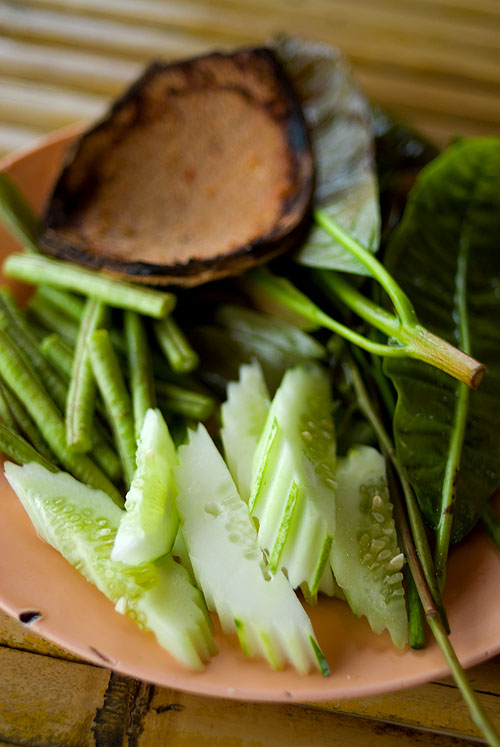
Shrimp paste pounded up with coconut meat, shallots, chilies and crab, smeared on the inside of a coconut shell then grilled over coals and served with local herbs such as young cashew tree leaves. This dish is given to everybody who walks in the door, and is far from being a throwaway appetizer. I'd be more than happy with a few of these and the previously mentioned coconut rice.
The first dish I ordered was plaa hoop ping:

Flying fish (plaa nok en) that is splayed, coated with a coconut milk/plack pepper/turmeric mixture, then grilled. The result is smokey, salty, oily--everything you'd want in a fish dish.
Yam saaraay:

A Thai-style 'salad' of a local variety of seaweed, which included sour mango and cockles, and oddly, peanuts.
The owner didn't exactly have to twist my arm to convince me to try two of Surat Thani's famous oysters:
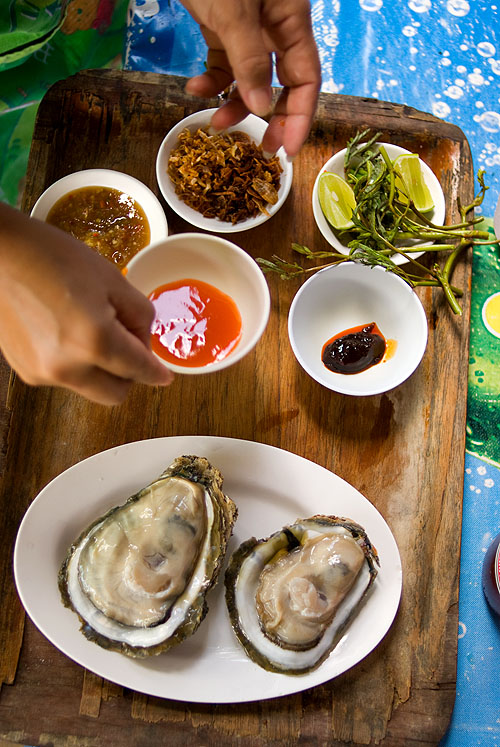
Served Thai style with accompaniments of naam phrik phao (a sweet/spicy chili sauce), lime, deep-fried crispy garlic and shallots, seafood dipping sauce and pungent krathin leaves. Despite how impressive they look, I found this the least interesting dish I ate at Bangpo Seafood. The oysters were simply too big, too tough, and had little flavour.
There was also plaa insee phat chaa:
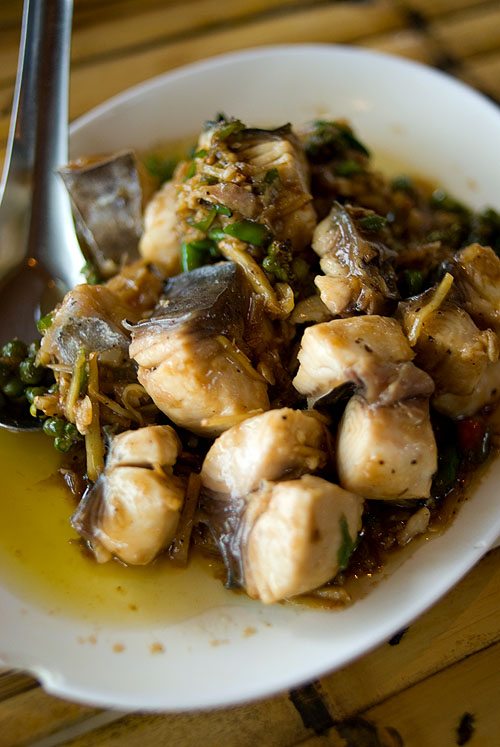
Mackerel stir-fried with fresh herbs. Very oily, as you can see, but the mixture of green peppercorns, krachai (Chinese key--a ginger-like root), garlic, Kaffir lime leaves and fresh fish was outstanding.
And these are just the dishes I ordered. While I was wondering how I could possibly consume all this, the owner's wife brought out a couple more dishes for me to try, including tom som waay:

a soup of a kind of small octopus made sour by the addition of tender young tamarind leaves, as well as several tiny deep-fried fish that one eats in one go, head and all.
And you know what? Other than the oysters, it was all outstanding.
So if this isn't enough to convince you to hop on the next plane, I don't know what else I need to do. However, a brief word of warning: apparently in the same area there are a couple identically named restaurants serving inferior food. If you aim to go to this one, be sure to make certain that you're at Ta Khoe's (the owner, pictured at the top of the post) restaurant.
The entire photoset can be seen here.
Bangpo Seafood (Ta Khoe) 6/4 Moo 6, Mae Nam Ko Samui 077 420 010 lunch & dinner
What are all these tourists looking at?
 Dancing ladyboys along Thanon Bangla, Patong, Phuket, of course:
Dancing ladyboys along Thanon Bangla, Patong, Phuket, of course:

Art at work
 Reproducing famous works of art at Chaweng Beach, Ko Samui.
Reproducing famous works of art at Chaweng Beach, Ko Samui.
A work of art
 Lunch at an unidentified curry restaurant, Ko Samui. Isn't food beautiful?
Lunch at an unidentified curry restaurant, Ko Samui. Isn't food beautiful?
Vendor, Chaweng Beach, Ko Samui
 This pic makes me smile. She was originally from Bangkok, is a housekeeper at one of the big hotels at night, and by day is a vendor on Chaweng. Buy something from her if you see her!
This pic makes me smile. She was originally from Bangkok, is a housekeeper at one of the big hotels at night, and by day is a vendor on Chaweng. Buy something from her if you see her!
Damn Spicy
 After several days on Ko Samui, I officially have no more reason to bitch about the lack of local eats. While staying on Lamai beach I discovered a stall at nearby Talat Dao that sells a variety of khanom jeen, curries served over fresh rice noodles. This is possibly the most common dish in southern Thailand, and is served at all times of day or night. Khanom jeen can also be got in other parts of Thailand, but what makes it different down here are the types of curries served and the toppings. Southern Thais like their chili heat, and the innocent looking, typically yellowish curries you'll see here are some of the spiciest in the country. The one pictured above is called naam yaa plaa (pictured above), and is a fish and coconut milk-based curry particular to the south. As with all types of khanom jeen, when you order you'll simply get a shallow bowl with a handful of noodles and a ladleful of curry. It's your job to top it with the fresh herbs and veggies held in vast trays on the tables. These herbs typically include a couple kinds of basil, young cashew nut leaves, phak chee lawm (an herb almost identical to flat leaf parsley, pictured above) cucumbers, long beans and a couple types of pickled veggies. It's all for free and you simply take what you like, rip it all up and mix it into your noodles.
After several days on Ko Samui, I officially have no more reason to bitch about the lack of local eats. While staying on Lamai beach I discovered a stall at nearby Talat Dao that sells a variety of khanom jeen, curries served over fresh rice noodles. This is possibly the most common dish in southern Thailand, and is served at all times of day or night. Khanom jeen can also be got in other parts of Thailand, but what makes it different down here are the types of curries served and the toppings. Southern Thais like their chili heat, and the innocent looking, typically yellowish curries you'll see here are some of the spiciest in the country. The one pictured above is called naam yaa plaa (pictured above), and is a fish and coconut milk-based curry particular to the south. As with all types of khanom jeen, when you order you'll simply get a shallow bowl with a handful of noodles and a ladleful of curry. It's your job to top it with the fresh herbs and veggies held in vast trays on the tables. These herbs typically include a couple kinds of basil, young cashew nut leaves, phak chee lawm (an herb almost identical to flat leaf parsley, pictured above) cucumbers, long beans and a couple types of pickled veggies. It's all for free and you simply take what you like, rip it all up and mix it into your noodles.
Another very southern type of khanom jeen is kaeng tai plaa, literally 'fish kidney curry':

I think this curry, which also includes crispy bamboo, grilled fish, long beans, and a type of sweet potato-like local tuber, is about the spiciest thing humans were meant to consume. As if that wasn't enough, it's also extremely salty. After eating it I was still feeling the burn a good 20 minutes later. Honestly though, it wasn't all that unpleasant. Have you ever eaten anything so spicy you actually felt a bit... well, high?
Breakfast on Ko Samui
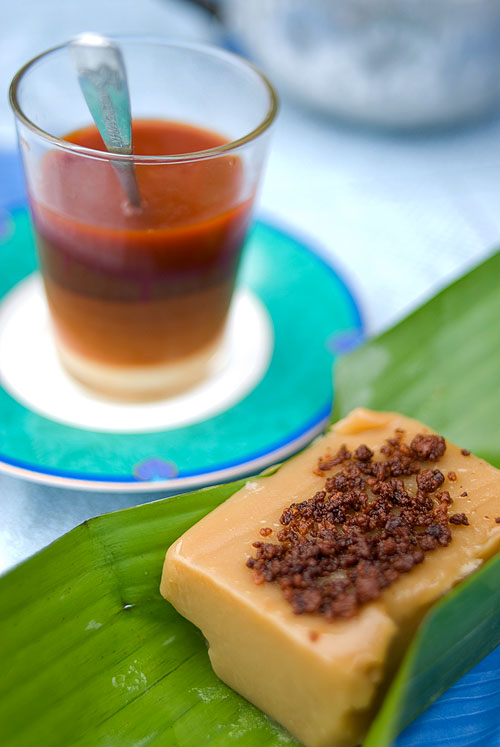 I've been on Ko Samui for almost a week now, and although finding real Thai food is not impossible, it can be something of a struggle. While on Lamai Beach I had a handsome meal of bangers and mash, was tempted to order pizza ('Chef from Naples'), and one night ate dinner at, uh... a Swedish restaurant (falukorv med stekt potatis och äkta svensk senap!). These were all satisfying, but I was still longing for something... local. I finally found it the next morning at Lamai's morning market. There I had a breakfast of sweet Thai tea with a Thai sweet (pictured above--name forgotten). Sweet, yes, but Thai. More to follow...
I've been on Ko Samui for almost a week now, and although finding real Thai food is not impossible, it can be something of a struggle. While on Lamai Beach I had a handsome meal of bangers and mash, was tempted to order pizza ('Chef from Naples'), and one night ate dinner at, uh... a Swedish restaurant (falukorv med stekt potatis och äkta svensk senap!). These were all satisfying, but I was still longing for something... local. I finally found it the next morning at Lamai's morning market. There I had a breakfast of sweet Thai tea with a Thai sweet (pictured above--name forgotten). Sweet, yes, but Thai. More to follow...
Na Thon
I'm on Ko Samui, doing the photos for Lonely Planet's upcoming Ko Samui Encounter guide. I have a big fat list of places I have to shoot, but the good thing about doing this job is when I come across something interesting I can usually just shoot away. This happened when I was taking photos of Na Thon, Samui's main port. It was sunset, and several ships had docked and were unloading fish:
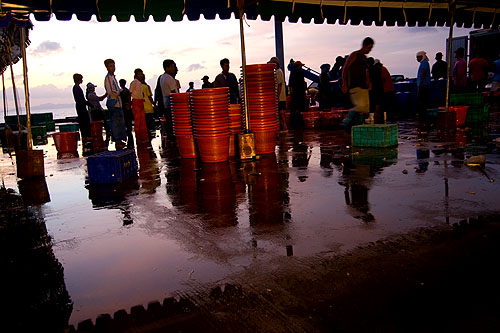
A bit later, the remaining natural light mixed with the fluorescent and tungsten lights of the boats to create a pretty cool effect:

If you look closely, you can see that they are filling the boat with ice, which also added an interesting element to the pic.
TV
Recently the Dutch television programme The Taste of Life was in Bangkok. I took them around town for a day, and even feature in part of the show! Apparently the video can be seen here, but I'm on the road and have yet to find a connection fast enough to accommodate streaming video. If you're blessed with amble bandwith take a look and let me know how silly I look.
Dinner in paradise
 I'm currently on Ko Pha-Ngan, a beautiful island in southern Thailand. At the moment, the water is clear, the weather sunny and I'm having a great time with old friends. There's only one downside: the food is bloody awful. Actually, that's a bit too strong. The food here isn't unsanitary, or rotten or even that badly prepared. It's just phenomenally bland. A boring, uninteresting approximation of Thai food for gastronomically timid foreigners. To make things even worse, every restaurant on Haad Yao seems to have the identical menu, and they staunchly refuse to vary from this. Among the more bizarre things that I've been served is something called Haad Yao fried rice (pictured above), rice fried with ketchup and chicken, and wrapped in a thin omelet. You can opt for the classic Thai dishes, but unless you're a fan of limp, salty 'kana with garlic', greasy phat thai, or milky tom khaa, you're screwed.
I'm currently on Ko Pha-Ngan, a beautiful island in southern Thailand. At the moment, the water is clear, the weather sunny and I'm having a great time with old friends. There's only one downside: the food is bloody awful. Actually, that's a bit too strong. The food here isn't unsanitary, or rotten or even that badly prepared. It's just phenomenally bland. A boring, uninteresting approximation of Thai food for gastronomically timid foreigners. To make things even worse, every restaurant on Haad Yao seems to have the identical menu, and they staunchly refuse to vary from this. Among the more bizarre things that I've been served is something called Haad Yao fried rice (pictured above), rice fried with ketchup and chicken, and wrapped in a thin omelet. You can opt for the classic Thai dishes, but unless you're a fan of limp, salty 'kana with garlic', greasy phat thai, or milky tom khaa, you're screwed.
Our only saving grace at this point has been a streetside som tam and grilled chicken stall about three kilometres up the road.

The proprietor is from Buriram, and makes papaya salad just the way I like it: sour and spicy. If you go to the same area in the morning, you'll even find, believe it or not, authentic southern Thai food such as khanom jeen. Unfortunately a taxi ride there (actually a seat in the back of a truck) costs more than the meal, so what would be a dirt cheap meal anywhere else in the country becomes an exorbitant splurge here.
In a couple days I'll be crossing over to Ko Samui, home I'm sure to even more quasi-Thai food, but also the location of Bangpo Seafood, a beachfront restaurant serving authentic Ko Samui-style Thai food that, despite having eaten there only once, I still count as one of my most memorable eating experiences in Thailand. Can't wait.
Maps
View Larger Map
A while back, I started showing the locations of the places I mention in Google Maps. As some of you pointed out, the maps were written in Thai--not a great deal of help to most of the people who come here. Fortunately, in glancing at my Google Map today, it appears that it now includes both Thai and English. So, please take a look, click on whatever looks good, and hope this tool helps you find it!











